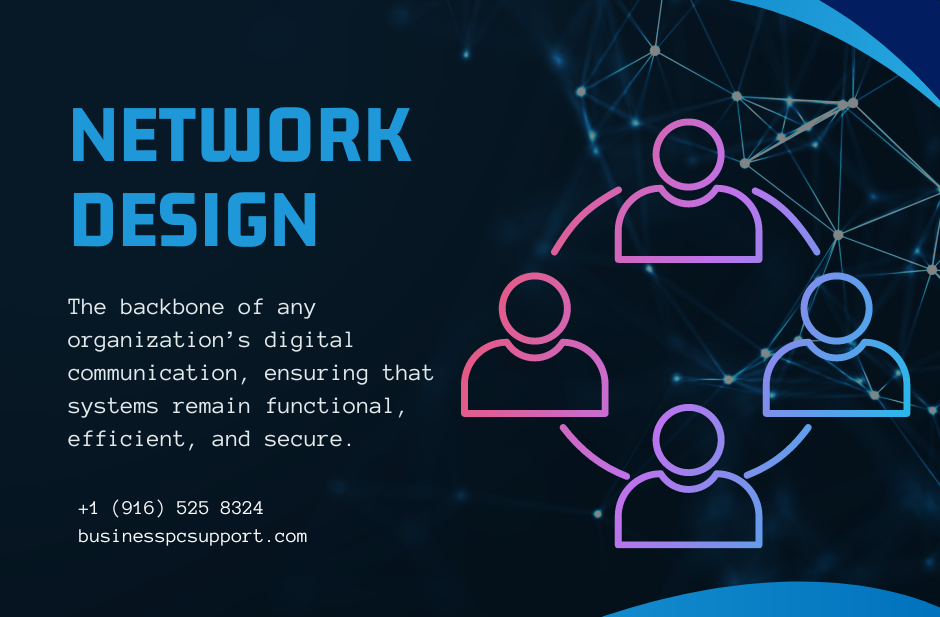7 Essential Tips for Effective Network Design in Elk Grove (Boost Efficiency & Security)
Table of contents
- What is Network Design?
- Key Elements of a Robust Network Design
- Types of Network Designs
- Network Design for Businesses in Elk Grove
- Tailoring Network Design for Small vs. Large Businesses
- Essential Hardware for Network Design
- The Role of Cloud in Modern Network Design
- Steps in Network Design Process
- Common Challenges in Network Design
- Future Trends in Network Design
- Network Security Considerations
- Network Design Consulting in Elk Grove
- How to Choose the Right Network Design Consultant
- Cost of Network Design in Elk Grove
- Importance of Scalability in Network Design
- Network Design Case Study: Elk Grove Business
- Frequently Asked Questions (FAQs)
- Conclusion
Network design is the backbone of any organization’s digital communication, ensuring that systems remain functional, efficient, and secure. For businesses in Elk Grove, the need for a well-structured and future-proof network design is even more critical as the city continues to expand and embrace technology in various sectors, from retail to healthcare.
In this article, we’ll dive deep into network design, covering the essential components, challenges, and benefits, with a specific focus on the needs of businesses in Elk Grove. Whether you’re a small business owner looking to upgrade your system or a large corporation needing a custom network, this guide will help you understand everything about network design.
What is Network Design?
At its core, network design refers to the planning and structuring of a communication framework that connects multiple devices, such as computers, servers, and mobile devices. The design focuses on creating an architecture that allows data to flow efficiently and securely across all connected devices. For an in-depth guide on network design basics, check out Cisco’s guide to network design.
Key components of a well-designed network include:
- Topology: The physical and logical arrangement of the network’s components.
- Security: Measures to protect data integrity and privacy.
- Redundancy: Ensuring backup systems are in place to avoid data loss or downtime.
- Scalability: The network’s ability to grow and adapt to future needs.
Key Elements of a Robust Network Design
A successful network design includes several critical elements that ensure the system remains efficient and can scale with the business’s growth. The most important factors include:
- Architecture: Whether it’s a simple LAN (Local Area Network) for a small office or a more complex WAN (Wide Area Network) connecting multiple locations, the architecture forms the blueprint of your network.
- Redundancy: Backup systems and failovers are vital for businesses to avoid data loss during system failures.
- Scalability: A good design ensures the network can grow without significant overhauls.
- Security: Firewalls, encryption, and access controls are paramount to keeping data safe. Learn more about best practices in network security from Kaspersky’s security insights.
Types of Network Designs
There are several types of networks, each serving different needs:
- Local Area Network (LAN): Used to connect devices within a small area like an office or home.
- Wide Area Network (WAN): Spans larger geographical areas, connecting multiple LANs. Learn more about WAN architecture at Techopedia’s explanation of WANs.
- Software-Defined Networks (SDN): A modern approach that allows businesses to manage and optimize their networks via software, enhancing flexibility and efficiency.
Network Design for Businesses in Elk Grove
For Elk Grove businesses, having a reliable and scalable network design is crucial. As more companies shift towards digitalization, a robust network not only improves day-to-day operations but also enhances customer experiences and strengthens security.
Elk Grove’s economy, fueled by industries like healthcare, retail, and technology, demands a network design that can accommodate high levels of data traffic, ensure cybersecurity, and maintain consistent uptime.
Tailoring Network Design for Small vs. Large Businesses
The needs of a small business differ significantly from those of larger enterprises. For example:
- Small Businesses: Typically require simpler designs like LAN, with limited hardware but still ensuring essential security measures like firewalls.
- Large Corporations: May need more advanced setups, such as WAN and SDN, to connect multiple locations and provide cloud access for employees.
Essential Hardware for Network Design
The key hardware components in any network design include:
- Routers: Direct traffic between different networks.
- Switches: Manage data flow within a single network.
- Firewalls: Protect against unauthorized access and cyber threats.
- Servers: Store, manage, and process data.
Investing in high-quality hardware is essential for ensuring the long-term success of your network design.
The Role of Cloud in Modern Network Design
With more companies migrating to cloud-based solutions, the integration of cloud into network design is becoming essential. Hybrid networks, combining on-premises and cloud-based infrastructures, offer flexibility, scalability, and cost-effectiveness for businesses of all sizes.
For a deeper dive into cloud networking, you can explore Amazon Web Services’ cloud architecture guide.
Steps in Network Design Process
The network design process typically includes:
- Planning: Assessing the business’s needs and determining the best type of network.
- Design: Creating a blueprint for the network’s architecture, security, and hardware.
- Implementation: Setting up the physical and logical components.
- Optimization: Regularly monitoring and updating the network to ensure optimal performance.
Common Challenges in Network Design
Some common challenges faced during network design include:
- Bandwidth Issues: Ensuring there’s enough capacity for data-heavy operations.
- Latency: Delays in data transfer can cause significant disruptions.
- Security: Safeguarding against cyber threats is a constant concern, particularly for larger networks.
Future Trends in Network Design
Emerging trends such as AI-driven network management, IoT (Internet of Things), and 5G technology are transforming the way networks are designed and operated. These innovations allow for more efficient data handling, better security, and more flexible network scaling options.
Network Security Considerations
Network security is a major concern for businesses, especially those handling sensitive customer data. Firewalls, intrusion detection systems, and encryption protocols are essential components of a secure network design. Regular security audits and updates are also recommended to address evolving threats. For more advanced information on intrusion detection systems, you can visit Palo Alto Networks’ Security Solutions.
Network Design Consulting in Elk Grove
Choosing the right network design consultant in Elk Grove can make all the difference. Many local providers offer customized solutions, but it’s crucial to look for consultants with a solid track record, experience in your industry, and an understanding of the latest network technologies.
How to Choose the Right Network Design Consultant
When selecting a network design consultant, consider the following:
- Experience: Look for professionals who have worked with businesses of your size and industry.
- Expertise: Ensure the consultant is familiar with the latest networking technologies and trends.
- Client Reviews: Check past client reviews and testimonials to gauge satisfaction levels.
Cost of Network Design in Elk Grove
The cost of network design varies depending on several factors, including the size of your business, the complexity of the network, and the level of security required. It’s essential to set a clear budget and get multiple quotes to ensure you get the best value for your money.
Importance of Scalability in Network Design
As your business grows, your network needs to grow with it. A scalable network design ensures that your infrastructure can handle increased traffic and additional devices without requiring a complete overhaul, saving you time and money in the long run.
Network Design Case Study: Elk Grove Business
Let’s take a look at a real-world example of network design success in Elk Grove. A local healthcare provider needed a scalable and secure network to handle patient records and telemedicine services. After implementing a hybrid network with cloud solutions, they saw a 50% increase in system uptime and a 30% reduction in IT costs.
Frequently Asked Questions (FAQs)
1. What is the most important aspect of network design?
The most crucial aspect is ensuring that the network is secure and scalable. A well-designed network should be able to grow with your business while keeping data safe.
2. How much does network design cost?
Costs vary based on factors like the complexity of the network and the specific needs of the business. Typically, small businesses spend less than large enterprises.
3. Can I design my network myself?
While small-scale networks can be set up by non-experts, it’s recommended to consult with a professional for businesses to ensure scalability, security, and efficiency.
4. What are the key components of a network design?
The key components include routers, switches, firewalls, and servers, along with a secure and scalable architecture.
5. Why is network redundancy important?
Network redundancy ensures that backup systems are in place in case of a failure, reducing the chances of downtime and data loss.
6. What are the benefits of a cloud-based network?
Cloud-based networks offer flexibility, cost savings, and ease of scaling, making them ideal for businesses with fluctuating or growing data needs.
Conclusion
Effective network design in Elk Grove is crucial for any business looking to optimize its operations, ensure security, and prepare for future growth. By focusing on scalability, security, and employing expert consultants, businesses in Elk Grove can establish a network infrastructure that supports their goals and future-proofs their IT systems.




Comments are closed